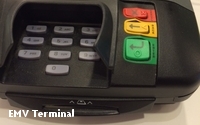 Mobile payments may get a shot in the arm with the new
credit cards coming.
Mobile payments may get a shot in the arm with the new
credit cards coming.
But that boost may be delayed by the lack of adoption by businesses.
As anyone who recently received a new credit card may be aware, chips are now being embedded
in the cards.
This is all part of the new liability standard with the terrible acronym of EMV, which stands for Europay, MasterCard and Visa.
In other countries, the cards also are
referred to as chip and pin, since a card is inserted into a terminal and the consumer enters a PIN number to complete a transaction. The U.S. version is more like chip and sign, since
the consumer will sign after the card payment is verified.
Starting in October, any merchant not set up for EMV cards assumes the liability for fraud, currently handled by the credit card
companies.
But based on a number of market-reads, consumers may not be using their new cards in the way they were intended at many places that they shop. For example:
- Only about
half (48%) of small businesses will be set up to take EMV cards by the October deadline, according to a survey by Cayan. However, more than a third (37%) has no plans to accept EMV cards at all. The
study comprised a survey of 344 small business owners and managers at companies with fewer 50 employees.
- More than half (55%) of business decision makers say the October deadline should be
extended, according to a survey by Randstad Technologies. That survey of 84 execs in large-scale, national businesses found that 42% of companies have taken no steps or are unaware of any progress
being made around EMV.
- Almost a third (28%) of small business owners who process payment cads are not even aware of EMV, according to a survey of 1,600 small business owners by Manta.
- About one in four (42%) small business owners have not heard of the EMV liability shift deadline, according to a survey of small business owners conducted by Ebiquity for Intuit.
You get the idea.
The reason EMV could impact mobile payments is not because of the technology but rather because of the behavioral change.
While not the most secure technology on
the planet, a credit card swipe is lightning fast.
Consumers are used to this. One swipe, maybe a signature, and done.
Not so with EMV.
The chip card gets inserted into the
payment terminal and the consumer waits. Then the consumer has to remember to take the credit card out of the machine. These are changes in how people will be required to pay.
And that’s
the opportunity for mobile payments to kick in.
A tap of a phone with Apple Pay or Android Wallet suddenly may look more appealing than the new, insert-the-card process.
While a mobile
phone payment may be slower than a credit card swipe, it likely always will be faster than an EMV card transaction.
But then again, EMV has to be widely deployed at merchants for the
difference to be noted.
Consumers may be in the driver’s seat on this one. More than half (57%) of small businesses would adopt EMV if customers complained enough about not being able to
insert their EMV chip card, according to the Cayan survey.
If consumers complain that they want to use their new cards, many may find using their phone is a better way to pay.